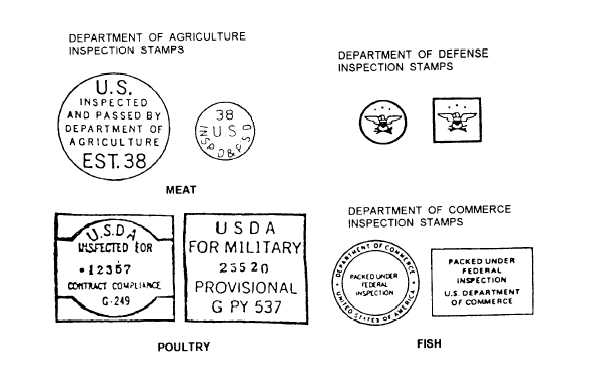| |
Figure2-1.—Meat, poultry, fish, and their by-products inspection stamps.
medical officer.
Examples of hazardous food item
characteristics are widespread presence of swollen or
leaking cans and products with either offensive or
unusual odors and colors or any other evidence of
deterioration.
Refer to the NAVSUP P-486, volume I, for more
information regarding the reporting and handling of
nonhazardous and hazardous food items.
Discrepancies in Shipment
It is always possible that several discrepancies can
occur during shipment and receipt. All of these can be
discovered during careful inspection and verification of
receipts. The following actions will be taken when these
discrepancies are found.
SHORTAGES IN SHIPMENT.— A shortage
occurs when the quantity received is less than the
quantity shown on the receipt, regardless of the quantity
on the original requisition. If a shortage exists, contact
the issuer or shipper, either in person or by message, to
try to resolve the discrepancy. Refer to NAVSUPINST
4440.179 for further guidance. Shortages due to
transportation discrepancies will be reported according
to NAVSUPINST 4610.33. Receiving activities will
notify the supply/transportation officer of all
transportation discrepancies upon their discovery. For
all types of discrepancies, the receipt inspector and the
bulk storeroom custodian will indicate on the receipt
document the actual quantity physically received by
drawing a single line through the invoice quantity and
recording and circling the actual quantity. Both will
then sign and date the receipt documents. (See figs. 2-2
and 2-3.) Forward the documents to the FSO.
When substantial shortages are found in shipments
received from Navy supply activities (Navy supply
centers [NSCs] or Navy supply depots [NSDs]) or
combat logistics force ships (AFSs, AFs or AORs), you
should immediately contact the issuer/shipper in person
or by message to resolve the discrepancies. In the event
shortages do exist after investigation, the full quantity
and dollar value of the invoice will be posted to the
Subsistence Ledger, NAVSUP Form 335; the Record of
Receipts and Expenditures, NAVSUP Form 367; and the
Requisition Log, NAVSUP Form 1336. The quantity
and dollar value of the loss of $50 or more per line item
will also be posted to the records according to the survey
procedures found in the NAVSUP P-486, volume I.
Losses of less than $50 per line item will be documented
as a loss without survey.
OVERAGES IN SHIPMENT.— An overage
occurs when the quantity physically received exceeds
the quantity stated on the receipt document regardless
of the quantity on the original requisition or purchase
order. When this occurs, immediate liaison is to be
established with the issuer to resolve the discrepancies.
2-3
|

